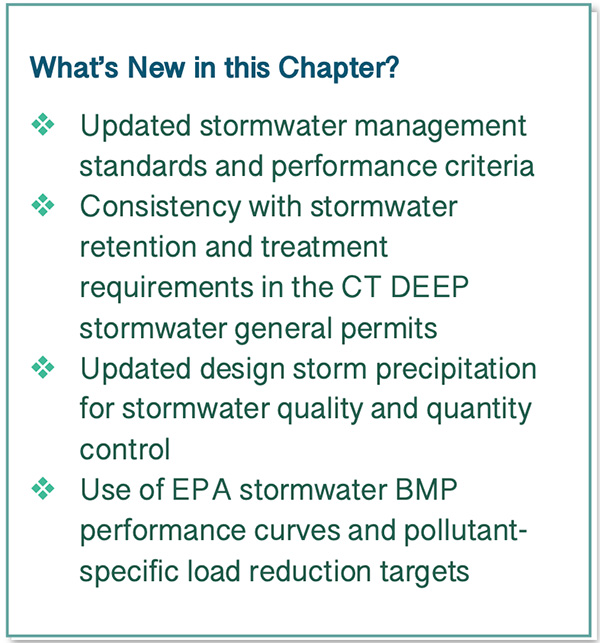Click on the headers for PDF access of these sections of the Manual
Introduction
This chapter presents stormwater management standards and performance criteria for land development projects in Connecticut. The standards and performance criteria apply to all new development, redevelopment, retrofits, and other land disturbance activities, whether considered individually or collectively as part of a larger common plan, which are subject to local, state, or federal regulatory requirements to address post-construction stormwater management.
Project proponents are required to meet and demonstrate compliance with the management standards and performance criteria using non-structural Low Impact Development (LID) site planning and design techniques and structural stormwater Best Management Practices (BMPs), in addition to operational source controls and pollution prevention. The management standards and performance criteria are intended to help preserve pre-development site hydrology and pollutant loads to the maximum extent possible to protect water quality, maintain groundwater recharge, and prevent flooding.
The performance criteria address the full spectrum of storm flows and their associated water quality and quantity impacts. These range from smaller more frequent storms that are
responsible for a majority of the annual runoff volume and pollutant loads, to larger less frequent events that can cause flooding. Given the observed and anticipated future increases in precipitation as a result of climate change, the performance criteria include updated design storm precipitation amounts and intensities for more resilient stormwater management designs.
The management standards and performance criteria presented in this Manual are intended to be consistent with the post-construction stormwater management requirements of the CT DEEP stormwater general permits, as well as local requirements within municipal planning, zoning, and stormwater ordinances and regulations. Some differences may exist between the standards and performance criteria in this Manual and local requirements. For example a local Inland Wetlands and Watercourses authority may require to maintain certain flow levels with respect to a downstream wetland, shallow water body, vernal pool, or small watercourse, etc. Where local requirements are less stringent than noted in this Manual, the intent of this Manual is to provide recommended guidance based on the most relevant science at the time of its publication.
Standard 1: Runoff Volume and Pollutant Reduction
Standard 1 works to preserve pre-development hydrology and pollutant loads in order to protect water quality and maintain ground water recharge by retaining / treating stormwater runoff. It is made up of 3 parts:
- LID Site Planning and Design:
- Ensure non-structural LID site planning and design techniques are considered at an early stage in planning process and integrated into design
- More information on performance criteria in Chapter 5
- Stormwater Retention:
- Retain on-site the applicable post-development stormwater runoff volume for the site (Required Retention Volume)
- Update of the water quality storm variable within the water quality volume equation. It has increased from 1 inch to 1.3 inches
- Stormwater Treatment:
- Stormwater treatment without retention must be provided for post-development runoff volume which is not met by required retention volume on-site
This section provides key information about each section, performance standards, how to demonstrate compliance, and in-depth calculations for retention and treatment.
Standard 2: Stormwater Runoff Quantity Control
Standard 2 focusses on maintaining pre-development peak runoff rates and managing the volume and timing of runoff to prevent downstream flooding, channel erosion, and other adverse impacts. It is made up of 3 sections:
- Peak Runoff Attenuation for Site Development / Redevelopment
- Control of 2 year post development flow rate to 50% of predevelopment rate
- Control of 10 year post development flow rate to predevelopment rate
- Potentially control 100 year post development flow rate to predevelopment rate (as required)
- Conveyance Protection
- Design conveyance system for on-line structural stormwater BMPs to be based on 10 year or larger storm
- Design conveyance system based on peak flow rate of largest storm for which peak runoff attenuation is provided
- Emergency Outlet Sizing
- Size emergency outlet of on-line stormwater quantity control structures to safety pass post-development peak flow rate from 100 year storm
Standard 3: Construction of Soil Erosion and Sediment Control
All construction projects and land disturbance activities should have effective soil erosion and sedimentation control measures, along with a Soil Erosion and Sediment Control Plan, in accordance with the Connecticut Guidelines for Soil Erosion and Sediment Control.
Standard 4: Post-Construction Operation and Maintenance
Projects must have a long-term operation and maintenance plan to identify required inspection and maintenance for structural stormwater BMPs. More information can be found in Chapter 6.
Standard 5 - Stormwater Management Plan
Stormwater Management Plans are required for documented the proposed stormwater management measures and how they meet standards, performance criteria, and design guidelines. More information can be found in Chapter 12.
